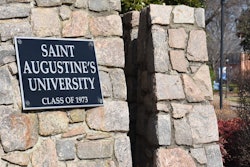Retilling The Field
Historically Black land-grant institutions are growing agricultural programs despite a difficult climate.
“As my mother used to say: ‘There’s more than one way to get in a house other than going in the front door.'”
That piece of wisdom is offered by Dr. James H. Walker Jr., the senior associate research director of the 1890 Evans-Allen Research Program at South Carolina State University. The “house” to which he refers figuratively is agriculture — and the means of entry is agriculture education.
Though the front door of agriculture appeared to be closing on African Americans — as indicated by the declining number of Black farmers as well as a diminishing number of schools and departments of agriculture at historically Black land-grant institutions — HBCUs are finding other ways of getting into the house.
“While we do want to have Black ownership of farms, we recognize the reality of the situation — that the students need to learn to be productive in that big agribusiness industry out there,” says Dr. Lucy J. Reuben, Dean of Business at South Carolina State University.
The degree in agribusiness seems to have replaced the degree in agriculture at many HBCUs. And while agribusiness education has many of the components of agriculture education — like raising crops and livestock and conducting research — the course of study is designed to prepare students for many different aspects of the food processing chain.
“There are so many ways to combine agriculture with other disciplines,” says Verneta Gaskins, a graduate student conducting agricultural research in the Biotechnology Center at the University of Maryland-Eastern Shore. “There’s more to [agriculture education] than just picking.”
For example, Gaskins has been experimenting with verticillum wilt, a condition that produces spores that choke the vascular system of plants, inhibiting their ability to absorb water. And fellow graduate student Candace Burnette has been poring over taste-test surveys in search of the proper combination of moisture, firmness and texture that will translate into high marketability for the food products being examined.
Regardless of the proliferation of agribusiness education opportunities, the decline in the number of Black farmers is worrisome — despite the generations-old trend. The slavery stigma, discrimination, second-class funding of historically Black colleges of agriculture — the land-grant schools founded for Blacks in 1890 as opposed to the traditionally White 1862 land-grant institutions — and the sacrifice of those schools at the altar of desegregation have all contributed to the current problem.
For example, after the Adams v. Richardson ruling in the early 1970s, South Carolina State lost its school of agriculture — among other things.
“When Adams came, the Department of Health, Education and Welfare was required to issue official desegregation guidelines,” explains Dr. Christopher Brown, a professor of education at the University of Illinois at Urbana/Champaign who attended S.C. State as an undergraduate at that time. He would later become an instructor in the institution’s School of Education. “That’s when they first started talking about program duplication and enrollment and faculty demographics.”
To meet the federal guidelines, the states involved engaged in negotiations with their colleges and universities over programs, funding and the racial demographics of the institutions. Because Clemson University already had an agriculture school, S.C. State agreed to give up its school of agriculture in exchange for an agribusiness program — which was to be the only such program in the state.
“We no longer have a college of agriculture but we do have a program in agribusiness” that is part of the business school, Reuben says. “We believe that in the business school, we are putting forth a model of agriculture management … that will benefit the farmers of South Carolina.”
According to Reuben, her institution’s agribusiness program runs on “two tracks, so to speak. On the one hand, we have outreach and conventional assistance to farmers [including] a rural development and cooperative development component. We stress modern management techniques [that will help both] agribusiness [and] farm management and cooperative development.
“At the same time, we have a very modern managerial-oriented agribusiness program,” she continues. “We carry on a number of workshops and seminars that will assist farmers throughout the state and at our centers and business school. We try to assist farmers directly in applying managerial perspectives appropriately in the contest of farm
management.”
However, there are those who feel that South Carolina State and many of the other 1890 institutions — and their students — got shortchanged in the negotiations with their state governments and higher education boards.
“Clemson still maintains the largest ag. program in the state,” Brown laments, yet the institution only graduated four Black students with bachelor’s degrees in agricultural sciences in 1998. “South Carolina State has an 1890 program that is significantly smaller in scope.”
And Brown finds that somewhat ironic because, “the HEW guidelines had a requirement that each state’s desegregation plan include efforts to assist Black colleges and to maintain and support those colleges.”
In 1988, while William Bennett was U.S. Secretary of Education, the Office of Civil Rights reviewed the 14 Adams states that submitted acceptable plans to see if they were in compliance with Title VI of the 1964 Civil Rights Act. Seven states were released from OCR oversight. Seven others — Ohio, Florida, Kentucky, Maryland, Virginia, Pennsylvania and Texas — were not.
Then in 1992, the Supreme Court ruled that the de jure states had a duty to remove all vestiges of past discrimination. According to Raymond Pierce of OCR, the standard was no longer a simple checklist. (see related story, pg.96) Now, if anything the state did has a leftover effect, that state could be found in violation of the Civil Rights Act. The Clinton Administration then proceeded to address the remaining states that were not in compliance.
“When you look at states to see if there are any vestiges that could practically be eliminated, you look to several areas,” Pierce says. “The Supreme Court said we should be looking at funding, mission statements and infrastructure and facilities. And they said we needed to determine whether or not there were any programs that were being unnecessarily duplicated.”
But preventing the duplication of programs has been problematic.
“We have been fighting that off, but I don’t know how much longer we will be able to continue to fight it off,” Pierce says. “At some point, HBCUs are going to need other defenses [to maintain their programs]. The further you get from the time [when the discrimination was supposed to have occurred], the more difficult it will be to justify the need” for the OCR oversight.
“The goal has always been the desegregation of the state system of higher education and not the desegregation of the HBCUs,” Pierce maintains.
Officials at the University of Maryland-Eastern Shore seem to be taking Pierce’s advice on the issue of duplication.
“The Maryland Higher Education Commission refuses to duplicate programs,” says Dr. Carolyn B. Brooks, dean of the School of Agricultural and Natural Sciences at the UMES. “We’ve been trying to get a Ph.D. program in food sciences.”
In an effort to hurdle the obstacle, the university has brought a lawsuit before the Maryland courts that would allow the duplication of programs if obstacles prevent all students from accessing those offerings.
Brooks is also concerned that the 1862 schools are currently raising standards. That, she says, could affect the ability of many minority students to get the kind of education that they need to advance in the agriculture business.
“If you are going to raise the standards at the 1862s, then these minority students [who don’t meet those standards or need remedial help] aren’t going to get in there,” she says. And because of the standards, “ag. majors and graduate students are predominantly White.”
But Brooks does see the potential for change in that position — at least in her state — noting that the University of Maryland-College Park, the state’s only other land-grant institution, is interested in duplicating programs offered at UMES. That, she says, should make it easier to present her case for new course offerings.
“It’s not quite as bad as it was,” Brooks says. “But we have to fight for every little piece we get. If we want to duplicate, we have to partner with other schools. We can’t have our own program.”
Struggling Against Funding Inequities
The historical legacy of duplication has created problems of funding inequities in states that are now technically and legally desegregated.
“When you look at this issue, duplication was necessary historically in order to bring about equality,” South Carolina State’s Walker says. “But what happened in the duplication is that equality was not defined as: ‘If the 1862 [institution] gets $1 million then the 1890 [institution] gets $1 million.'” To the contrary, she says, desegregation introduced the appearance of equality but a reality of inequality as demonstrated by the inequitable way funds were allocated.
“In the future, there [may be] a trend towards moving away from that [kind of] dualism when we look at the quality of programs within each institution. But as long as dualism is defined in terms of dollars, there will always be inequality. It’s like saying: ‘You can do more because you get more, but I get less and I still have to do just as much.'”
Federal funding for state land-grant institutions is dependent on matching funds, usually from the state. At the 1862 level, the funding is based on a $1-to-$1 match. That is not the case where the 1890 institutions are concerned, Black higher education officials eagerly point out. Funding for those schools are based on matches that can be as low as 30 percent.
Because federal funding is based on a formula that relies heavily on farmers and farmland within a state, UMES receives the least of the federal funds for 1890 institutions, according to Brooks. And the size of the institution affects funding in several ways.
Noting that “we [at UMES] couldn’t make it without the formula funds” provided by the U.S. Department of Agriculture, Brooks says, “If it weren’t for the USDA, I don’t know what we would do. … Every time we want something, we have to ask for more [than just the basics]. We have to ask for more people. We have to ask for more equipment. The other [1862] schools already have it….
“We don’t have critical mass [among the faculty]. For instance, we have only one poultry scientist,” she says.
Last year, UMES received $400,000 from the state of Maryland. According to Brooks, that was old money — money that had already been budgeted. She says UMES was told to find the matching funds for the federal requirement within the state’s annual allotment and there would be no “new” money to make up the difference.
But Brooks sees funding help on the horizon. She is especially happy to see that West Virginia State University, which gave up its 1890 status in 1967, recently reapplied for the status and was approved. She says this is good for HBCUs because it gives the 1890 schools a powerful ally in their fight for increased federal funding.
“Sen. [Robert C.] Byrd [of West Virginia, the ranking Democrat on the Senate Appropriations Committee] is a mighty powerful voice,” Brooks says.
The disparity in funding between the traditionally White 1862 land-grant schools and the historically Black 1890 schools also has carried over to the industry side of the equation. Recently, the USDA admitted to discriminatory practices against Blacks when it settled a lawsuit that gave the nation’s African American farmers $50,000 each in compensation.
The settlement also provides for college-based initiatives aimed at helping America’s Black farmers, and as Brooks notes: “The 1890s have been working with small farmers for years and nobody [else] has done anything to help them.”
But now that the USDA has begun allocating money for programs that help small farmers, the 1890 schools are running into more competition for those funds.
“Everybody wants a small-farms program because the government has started putting money in them,” Brooks says. “The big institutions are realizing that it is in their own best interest to help small farmers. And a lot of them have been trying to use the small farmers [funds] in states with small Black populations like Texas, which is targeting Hispanics so that they can claim minority status whereas once, [minority status] was only Black.”
Shaking Agriculture’s Stigma as Slave’s Work
Another impediment that helps depress the number of Black farmers in this country is history.
“For African Americans, the stigma of agriculture is tied to slavery,” says Walker, who believes that the stigma is losing its hold on Blacks. “We have looked at agriculture more from the standpoint of slavery and not in the broader aspect of American life. So now, the colleges and universities are broadening that concept and not just focusing on the agricultural aspect.
“Agriculture is about the comprehensiveness of the human condition, and technology has created the tools to be used to address the human condition.”
“An urban explosion in the rural area has opened up the perception of agriculture in its true sense,” Walker continues. “This new paradigm has given the HBCUs the opportunity to be at the forefront of addressing agriculture in not only American life but on a global perspective. And when you talk global, color isn’t as important any more because it’s not a Black-White condition, but the human condition.”
Most higher education officials at HBCUs agree with Walker’s assessment. And they point to the return of agriculture programs at HBCUs to back up their claims. Aside from West Virginia State’s new status, Lincoln University in Missouri is re-establishing its school of agriculture.
According to Dr. Mary Wyatt, assistant to the president for planning assessment at Lincoln, the university did not have a school of agriculture until 1988. Before that time, there was a department of agriculture and agriculture has always been taught at the university as part of its land-grant mission. Then in the mid-1990s, the school of agriculture was disbanded and replaced with a department of agriculture. But on July 1, 2000, the university will upgrade its agriculture offerings by establishing a new College of Liberal Studies, Natural Sciences and Agriculture. Agricultural economics courses, however, will be housed in the school of business.
The mission of land-grant institutions is to provide research, teaching and public service. But teaching, according to Walker, has dominated the land-grant institutions, particularly at HBCUs.
“The [current] land-grant status opens up opportunity for our institutions,” he says. “Agriculture is just one component of that. The land-grant status has business, education, consumer sciences, human services” and other components as well.
“We have to look at opportunities in the things we have before us. We have become more integrated, more multidisciplinary,” he continues. “We are beginning to see the commonality in the different disciplines. Though we lost some things, greater opportunities are giving us the chance to reinvent agriculture to address the human condition in a more holistic way.”
Walker sees something very positive in “the trend toward integration, multidiscipline partnerships and collaboration, networking and building opportunities from a multidimensional perspective. When you expose students and faculty to real-life situations, it changes the whole complexion of educational deliverability.”
And according to Walker, agriculture is a key that can open a lot of doors for African Americans.
“The key to the land-grant schools is not agriculture in a limited sense, but agriculture in a broader sense,” he says. “Agriculture is the mother of everything. Talk about anything and it will tie back and link to agriculture. … Everything has evolved around agriculture. But agriculture is more than just farming. … Today, agriculture is information technology. And at the same time, it has been made more conscious of the need to cater to the all groups.
“Traditionally, the focus [of these land-grant institutions] has been on agriculture,” Walker continues. “But now, it’s more about families and people, which means that the rural connotation … is an attempt to recognize the human-services aspect of agriculture. This is where the thrust is in the 21st century — looking at how our programs are meeting the needs of the clientele defined in a broader context than it has been traditionally.”
As for the hoops that historically Black land-grant schools must jump through to enhance their agriculture programs, Walker says: “Things that start out from a negative standpoint, as time goes by, they become not a negative but a positive because it forces you to look at the opportunities that are there.”
© Copyright 2005 by DiverseEducation.com















